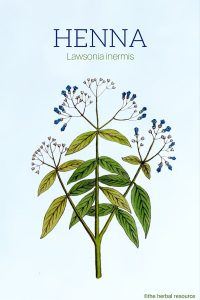Despite that henna has primarily be used as dye plant, it is also know for its medicinal properties. The leaves are used in traditional folk medicine in India, many Muslim countries and North Africa.
The herb is used in Ayurvedic and Unani medicine as a gargle for bad throat and extracts or decoction have been used as herbal remedies for diarrhea, amoebic dysentery, ulcers, tapeworms, and fever.
A decoction made from the bark has been used to treat some liver diseases.
Externally the leaves, due to their astringent effect, have been used to treat high fever, headache, joint pain and dermatitis.
As a treatment for a headache or fever, the dried leaves are mixed with water in order to make a paste that is then applied as a compress on the forehead.
In the Middle East, henna is an ingredient in eye lotions and antirheumatic liniments.
Many skin disorders are often treated with the herb, including eczema, fungal infections, injuries, wounds, burns, boils, acne, herpes, and scabies.

Leave a Reply